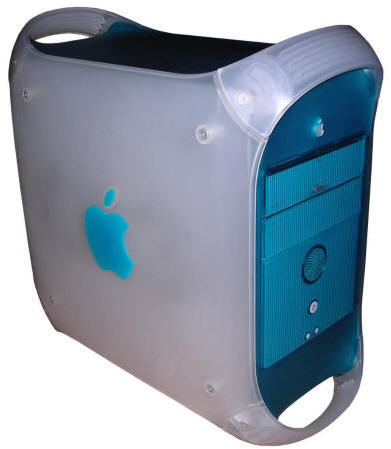Power Macintosh G3 Blue&White
In mid-1998, Apple released iMac - a new all-in-one
computer with unusual case and stylish shape. Lots of transparent and
white plastic made the computer closer to applied art and definitely
abandoned the "white box" case. iMac was characteristic and
distinguishable. However, Power Macintosh line computers were still in a
beige box casings. There was one all-in-one Power Mac with quite stylish
line, but it was not widely accessible. In early 1999, Apple released a
re-designed Power Mac, with style similar to iMac - translucent case
with large, but a bit blurred "G3" text, blue-green front panel colour
and big Apple logo were characteristic parts of a new Power Macintosh
G3, internally called "blue and white". As with power Macs, new
technologies have been used: RAM is in 100MHz DIMM modules and there are
new FireWire and USB connectors. Although this model did not left ADB
peripheral connector behind, keyboard and mouse supplied were connected
to USB. However, serial ports and floppy drive has been dropped.
This is the first model of its series - it contains 300MHz PowerPC G3
CPU and PCI graphics board. By default, it came with 6GB ATA hard drive
and 64MB of RAM, it allows for comfortable operating in Mac OS 8.5 as
well as later 9.2 version. The graphics board, used in PCI slot was ATI
XClaim VR first (in fact a Rage PRO with 4MB of RAM) and in a bit later
models a full 16MB ATI Rage 128. This line was kept until Power Mac G4
has been introduced in August 1999.
| Model No: | M5183 | |
| Year: | 1999 | |
| Discontinued: | 2000 | |
| CPU: | PowerPC G3 300MHz | |
| RAM: | 128MB | |
| Max. RAM: | 1GB | |
| RAM Type: | 4 PC100 DIMMs | |
| Hard disk: | 10GB IDE, 3.5" SL | |
| Floppy drives: | None | |
| Other drives: | CD-ROM | |
| Graphics: | PCI (ATI RAGE PRO 2x) Known as ATI XClaim VR, 4MB |
|
| Sound: | 3.5mm Jack sound input / output (Stereo), one built-in speaker. | |
| Display: | Depends on graphics card installed (default: VGA or Mac-VGA) | |
| Dedicated OS: | Mac OS 8.5 | |
| Maximum OS: | Mac OS X 10.4 | |
| Expansions: | USB, FireWire, Internal modem connector, AirPort internal expansion, ADB, 3 PCI slots. | |
|
Additional peripherals in collection: |
||
| Connectors: | - 2 USB
connectors - 2 FireWire connectors - Ethernet connector - Audio in/out - Graphics card output. - ADB connector
|
|
My unit has been used in some studio for scanning, so it had a SCSI board and LinoColor scanner software (to e.g. Saphil Ultra2 maybe?). Shortly after purchasing, its hard disk has been upgraded to 10GB one (9GB in Apple's notation) and RAM was doubled to 128MB. In last years of operation the RAM has been upgraded even more to 512MB. It was retired around 2015. Later, the SCSI board has been removed, as well as ISDN board and additional network board.
Here you'll find:
| Overclocking | Links |
Overclocking
Overclocking is relatively simple - there are jumpers
for it(covered with warranty seal) and they are even labeled like "SPEED
CONTROL" in some mainboard revisions. However, there are a few things to
consider:
1. The CPU is not cooled directly any way. The heatsink just is in the
mainboard, the air flow naturally caused by fans cools it down.
2. Avoid increasing system bus speed. This makes more problems than it
cures by overclocking all buses in a system.
3. Maintain temperature. Vertical position of this CPU is not fortunate,
so before any overclocking check thermal compound too.
So the settings are (S - Short with jumper) (source: xlr8yourMac):
| Multiple (CPU MHz) | 4 | 3 | 2 | 1 | -----> To the connectors -------> |
| 3x (300MHz) | S | S | S | Default for 300MHz unit | |
| 3.5 (350MHz) | S | Default for 350MHz unit | |||
| 4 (400MHz) | S | S | Default for 400MHz unit, 350 was overclocked to it | ||
| 4.5 (450MHz | S | In 400MHz CPU, thermal starts to complain | |||
| 5 (500MHz) | S |
Nope! |
|||
| 5.5 (550MHz) | S | S | |||
| 6 (600MHz) | S | ||||
| 6.5 (650MHz) | S | S | |||
| 7 (700MHz) | S | S | S |
http://lowendmac.com/2002/overclocking-the-blue-and-white-g3/ -
Overclocking description
http://www.xlr8yourmac.com/G3-ZONE/yosemite/OC.html - Exact
description what "Speed control" jumpers do.
http://www.xlr8yourmac.com/G3_OC/tims.html - Advanced overclocking
description in the lab notes
Warning: In the lab notes, xlr8yourmac placed jumper "1" closer to
the front of mainboard - jumper 1 is closer to connectors, to the rear!
Links:
-
http://apple-history.com/g3blue - Description in Apple History, as
well as comment about version with better ATA chip and HDD rack released
in mid-1999.





